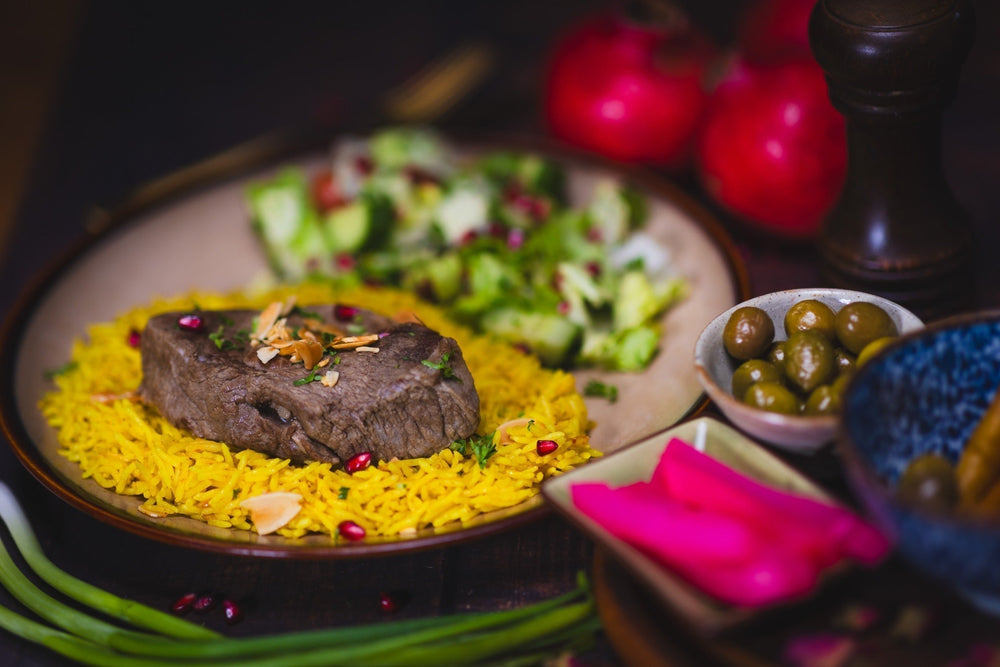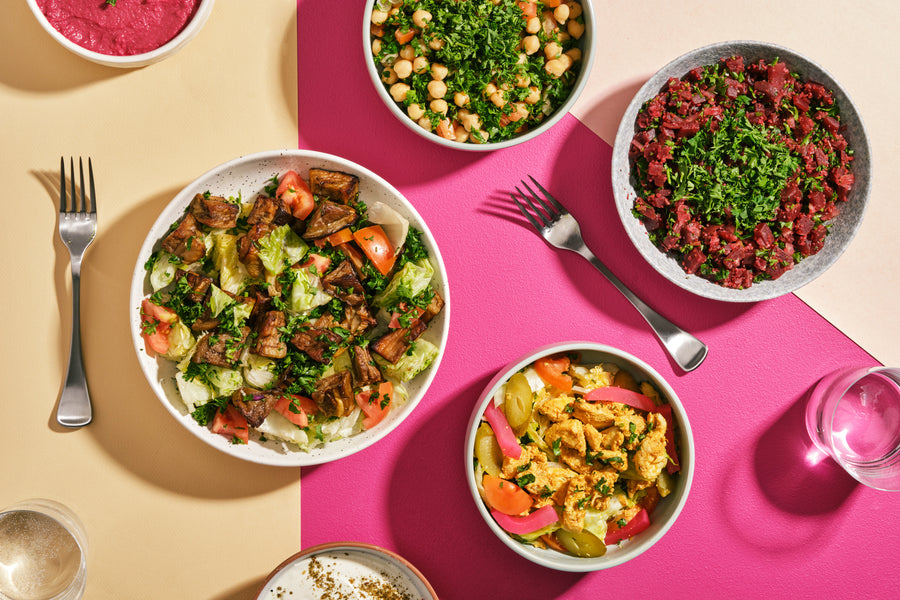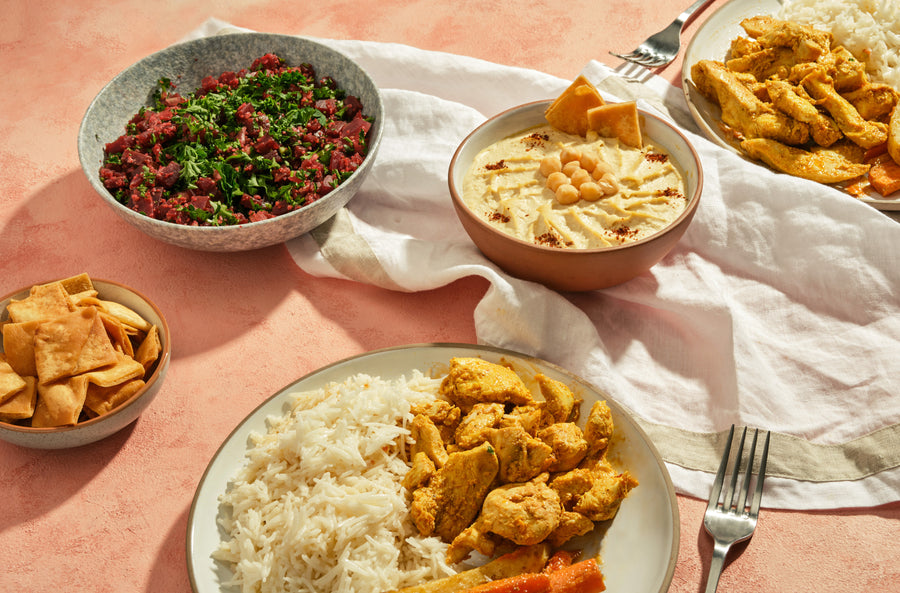Everything about the Rich Flavors and Traditions of Syrian Food: A Culinary Trip
Syrian cuisine uses an one-of-a-kind mix of tastes and customs that mirror its abundant cultural history. With staple active ingredients like olive oil and garlic, together with a selection of seasonings, the meals are both diverse and inviting. From the intricate preparation of kibbeh to the sweet attraction of baklava, each facet of this culinary landscape discloses deeper stories. As one explores the significance of these flavors, a greater understanding of public dining and celebration emerges.
The Essence of Syrian Active Ingredients
The significance of Syrian components exists in their abundant diversity and ingrained cultural relevance. Influenced by the country's diverse location and history, Syrian food includes a wide range of seasonings, herbs, and fresh produce. Staples such as olive oil, garlic, and lemon supply a structure, while seasonings like coriander, cumin, and sumac add depth and complexity to dishes.The use fresh herbs, including parsley and mint, highlights the value of seasonal ingredients. Furthermore, the region's productive dirt yields a wealth of fruits and veggies, such as tomatoes, eggplants, and pomegranates, which are essential to lots of dishes. Grains like bulgur and rice develop the base of several dishes, underscoring the relevance of these components in Syrian culture. This blend of tastes reflects not simply a culinary tradition but additionally a tapestry of historical influences, making Syrian ingredients vital to recognizing its food's lively character.

Iconic Dishes of Syrian Food
Syrian food is renowned for its legendary dishes that showcase an abundant tapestry of textures and tastes. Standard meze plates provide a selection of small dishes that entice the palate, while hearty main dishes provide enjoyable focal points for meals (Afternoon Tea Vancouver). To complete the experience, a choice of delectable desserts includes a sweet note to the culinary trip
Typical Meze Plates

Hearty Key Courses
Passionate main dishes act as the focal point of Syrian dining, showcasing a blend of tastes that mirror the nation's rich cooking customs. Recipes such as kebab hindi, featuring seasoned lamb skewers, and the celebrated mujaddara, a reassuring mix of lentils and rice, highlight using aromatic spices and fresh components. Another staple is the famous kibbeh, made from bulgur wheat and minced meat, often served in various types, including baked, fried, or raw. Furthermore, the flavors of the land come to life in recipes like packed vegetables, recognized as mahshi, which are full of rice, meat, and natural herbs. These main dishes not only satisfy appetite yet additionally inform tales of household gatherings and social heritage.
Delicious Treats Selection
A fascinating array of treats specifies the sweet side of Syrian food, offering an alluring end to any type of meal. Amongst the most well known confections are baklava, fragile layers of phyllo pastry loaded with nuts and saturated in syrup, and maamoul, shortbread-like cookies typically packed with nuts or dates. Knafeh, an abundant dessert made from slim noodle-like bread saturated in syrup and split with cheese, is a popular choice, especially during cheery events. Furthermore, the wonderful and aromatic rice dessert, understood as roz bil laban, provides a soothing finish. These scrumptious treats not just display the area's cooking experience yet also show the social heritage of Syria, making them treasured deals with in both restaurants and homes alike.
Traditional Cooking Techniques
Contemporary conveniences have actually affected many cooking methods, traditional food preparation methods continue to be essential to Syrian food. These techniques commonly emphasize the use of fresh, seasonal components and concentrate on slow-moving food preparation to establish rich tastes. Methods such as grilling, braising, and cooking are widespread, allowing the all-natural preferences of the ingredients to radiate through.One notable method is the prep work of kibbeh, a recipe made from finely ground meat and bulgur. It requires skillful hand-rolling right into numerous shapes and can be baked, fried, or served raw. Additionally, the art of making bread, especially pita, is central to numerous dishes, often prepared in a typical rock oven.Preservation methods like pickling and fermenting also play a crucial function, boosting the variety of tastes located in Syrian recipes. These strategies not just reflect the area's agricultural heritage yet also promote a strong feeling of area with shared culinary practices.

The Role of Spices in Flavoring
Seasonings work as the heart beat of Syrian cuisine, instilling dishes with complicated flavors and aromatic depth. Each flavor plays a pivotal role, adding not just to taste but also to the social heritage of the area. Generally utilized spices consist of coriander, sumac, and cumin, each providing a distinct account that raises conventional recipes. As an example, cumin offers warmth and earthiness, while sumac adds a tangy brightness, enhancing the general dish.Syrian chefs commonly blend flavors to develop harmonious accounts, reflecting the elaborate equilibrium of flavors that specify the food. Using flavors is not just for spices; it also offers to maintain food and enhance its nutritional value. This thoughtful consolidation highlights a deep understanding of the cookeries, where seasonings become vital writers, communicating the abundant history and diverse impacts that define Syrian gastronomy. Ultimately, flavors are vital in crafting unforgettable and genuine Syrian dishes.
Commemorative Dishes and Cheery Custom-mades
Commemorative meals in Syrian food are noted by traditional feast recipes that show the nation's rich culinary heritage. Special occasions often include distinct rituals that boost the common experience of eating. These customs not only recognize the importance of the occasions but additionally enhance domestic and social bonds.
Conventional Banquet Dishes
When households gather to celebrate significant celebrations in Syria, typical banquet dishes take spotlight, showcasing the abundant culinary heritage of the area. These events commonly include lively plates of mezze, consisting of hummus, baba ghanoush, and tabbouleh, which serve as fascinating starters. The main dish generally highlights lamb or hen, seasoned and cooked to excellence, usually come with by aromatic rice pilaf or bulgur. One of the most beloved dishes is maqlooba, a see here split rice dish with vegetables and meat, turned inverted prior to offering. Desserts also play a crucial function, with baklava and knafeh supplying a wonderful surface to the meal. Each meal not just thrills the taste buds yet additionally reflects the ingrained traditions and public spirit of Syrian culture.
Unique Celebration Rituals
Special occasions in Syria are marked by rich routines that link food and festivity, showing the cultural importance of public celebrations. Commemorative meals often consist of traditional meals such as kibbeh, tabbouleh, and numerous smoked meats, prepared with care and shared amongst friends and browse around this web-site family. During spiritual holidays like Eid al-Fitr and Eid al-Adha, families collaborated to prepare unique desserts like maamoul, representing unity and delight. Wedding events are particularly sophisticated, featuring multiple programs and vibrant display screens of friendliness. These occasions are not just about food; they encompass dance, music, and storytelling, reinforcing social bonds and social heritage. With these rituals, Syrians celebrate life's turning points, making certain customs are passed down through generations, improving their culinary landscape.
The Importance of Sharing and Community
Sharing meals is a fundamental element of Syrian society, showing the deep-rooted values of neighborhood and connection. In Syria, food is not just nourishment however a way of bringing people together. Family members and friends gather around the table to delight in typical recipes, fostering bonds and producing enduring memories. This communal dining experience emphasizes friendliness, where hosts most likely to great sizes to guarantee every visitor really feels invited and nourished.The act of sharing food also symbolizes generosity and solidarity, strengthening social connections within areas and bigger neighborhoods. Throughout celebrations, it is common for people to serve each various other, showcasing a spirit of togetherness that transcends uniqueness. Events, whether little or huge, are commonly noted by the sharing of meals, where diverse tastes and dishes come together, showing the rich tapestry of Syrian culture. Appropriately, the relevance of sharing and neighborhood in Syrian food is not only a culinary tradition yet a vital social technique.
A Cooking Expedition of Syrian Sweets
Although commonly outweighed by savory dishes, Syrian sweets hold a cherished place in the nation's cooking heritage. These confections mirror the region's abundant background, blending tastes and methods from numerous societies. Traditional treats like baklava, with its layers of phyllo pastry, nuts, and honey syrup, display the virtuosity associated with Syrian food preparation. Ma'amoul, a shortbread-like cookie loaded with nuts or days, is often gotten ready for festive events, symbolizing hospitality and celebration.Another beloved pleasant is Knafeh, a bread saturated in syrup and split with cheese or cream, providing a fascinating comparison of structures. Syrians additionally enjoy a range of fruit protects and syrups, frequently served with tea or as component of a bigger spread during events. These sweets not just satisfy the taste however also serve as a bridge between generations, protecting the traditions and stories of Syrian culture with each delightful bite
Often Asked Inquiries
What Are the Wellness Advantages of Conventional Syrian Foods?
The wellness benefits of typical Syrian foods consist of abundant nutrients from fresh vegetables, vegetables, and entire grains. These components promote heart health, improve food digestion, and offer necessary vitamins, contributing to total health and a well balanced diet regimen.
How Has Syrian Food Evolved Over the Years?
Syrian cuisine has actually evolved significantly, affected by historic profession courses, social exchanges, and local schedule of active ingredients. Typical dishes have actually incorporated contemporary flavors and techniques while preserving their rich heritage, mirroring a diverse culinary landscape.
Are There Vegetarian or Vegan Options in Syrian Food?
Syrian cuisine provides numerous vegetarian and vegan choices, featuring recipes like falafel, tabbouleh, and packed grape fallen leaves. These dishes highlight the region's rich farming heritage, official source showcasing fresh vegetables, grains, and fragrant spices in dynamic mixes.
What Beverages Set Well With Syrian Meals?
When thinking about drinks that complement Syrian dishes, one might find that mint pomegranate, tea, and ayran juice improve the dish's flavors. Furthermore, red wine commonly pairs well with the flavors frequently located in these cuisines.
Exactly How Can I Recreate Syrian Dishes in your home?
To recreate Syrian meals at home, one ought to discover genuine dishes, collect typical components, and make use of cooking techniques distinct to the food. Try out seasonings and presentation additionally boosts the total eating experience. Syrian cuisine is renowned for its famous meals that display a rich tapestry of appearances and tastes. Spices offer as the heart beat of Syrian cuisine, infusing recipes with complicated flavors and fragrant deepness. Commemorative meals in Syrian food are noted by traditional feast dishes that show the country's abundant cooking heritage. Celebrations, whether big or little, are often marked by the sharing of dishes, where diverse flavors and recipes come together, showing the abundant tapestry of Syrian culture. Syrian cuisine uses many vegan and vegan alternatives, including dishes like falafel, tabbouleh, and stuffed grape leaves.